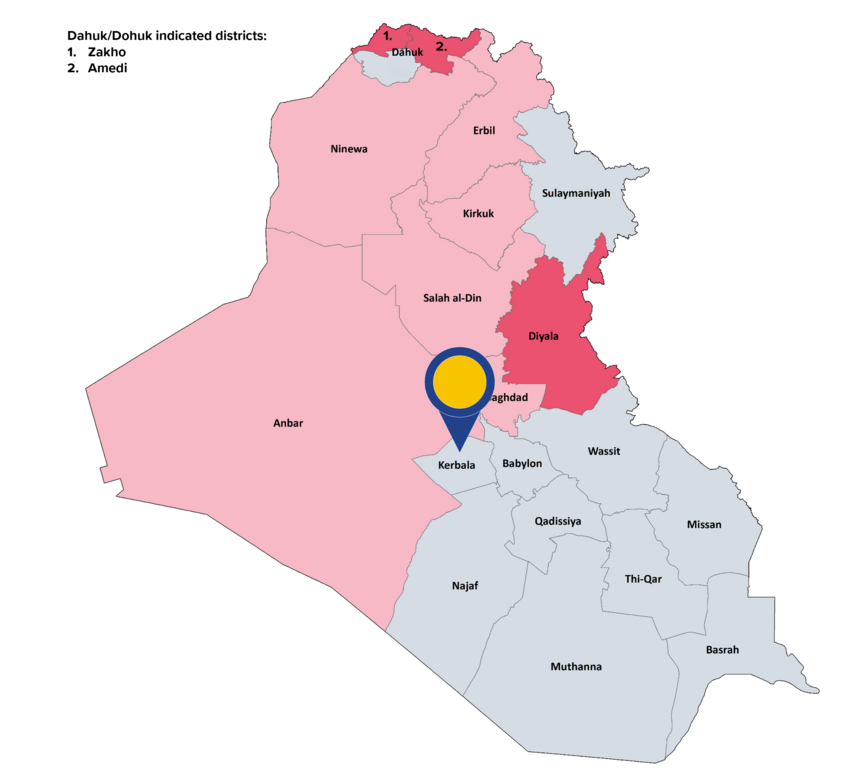COMMON ANALYSIS
Last update: June 2022
General information
Kerbala governorate is located in the central part of Iraq and borders Anbar, Najaf, and Babil governorates. It is divided into the following districts: Ain Al-Tamur, Al-Hindiya, Kerbala. The provincial capital is Kerbala. The Iraqi CSO estimated the governorate’s population for 2021 at 1 316 750 with around 880 400 people living in urban areas, with the majority being Shia Arabs. Karbala is a holy city to Shia Muslims. Religious tourism is a major economic factor in Kerbala.
Background of the conflict
Kerbala city has become a hotspot for conflict caused by the presence of dozens of powerful Iranian-backed militias and the competition of armed groups and political interests. Insecurity in Kerbala was mostly linked to religious uprisings and protests of the Shia population against the Iraqi government. In summer 2018 and since October 2019, continuing anti-government protests claimed fatalities and casualties. Impunity for politically motivated crimes against pro-reform activists aroused public anger.
Actors: control and presence
Kerbala governorate is under the control of the ISF. The Iraqi military’s Middle Euphrates Operations Command (MEOC) is operating in Kerbala and chiefly responsible for ensuring the security of Shia pilgrims. As of December 2019, ISF in Kerbala also included the 9th Armoured Division, commandos brigade, emergency regiments as well as local and federal police. Local security forces included paramilitary groups, such as the Iranian-backed militia Kata’ib Hezbollah.
PMF operating in Kerbala were reportedly the Shia militias Liwa‘ Ali Al-Akbar (Brigade 11) and the Al-Abbas Combat Division (Brigade 26). The MEOC, responsible for Kerbala and the regions to the southwest, is largely composed of these two factions. Hashd Al-Marji’i or Hashd Al-Atabat are unofficial labels for PMF groups affiliated to the holy shrines of Kerbala and Najaf. They are loyal to the religious leader Al-Sistani. In 2020, there also existed training camps for various factions (e.g. the Asa’ib Ahl Al-Haq, the Al-Abbas Combat Division and smaller factions) in Kerbala governorate.
In 2020 and 2021 intensified security efforts were made to ensure pilgrimage to Kerbala on the Shia commemorations of Ashura were not disrupted by violence. The plan to secure the road from ISIL activities involved the installation of checkpoints and ambushes as well as operation security patrols in cooperation with PMF.
Nature of violence and examples of incidents
The PMF reportedly repelled an attack by ISIL in May 2020 and shot down four drones that did not have official approval in September 2021. Clashes between the PMF and Kerbala police were also reported, leaving six people injured. Anti-government protests continued in 2020 and 2021. Violent clashes reportedly occurred between protesters and PMF and/or police in Kerbala city.
Explosive attacks on power supply lines and two transmission towers, an explosion of bomb from remnants, resulting in civilian casualties (1 death and 1 injured), and three bomb explosions that injured two police officers and one other person were recorded.
Incidents: data
In the reference period, ACLED recorded a total of 10 security incidents (average of 0.2 security incidents per week) in Kerbala of which 3 incidents were coded as battles, 3 as explosions/remote violence, and 4 as violence against civilians. UNAMI[34] recorded no armed conflict-related incidents taking place from 1st August to 31 December 2020 and 1 taking place from 1st January to 31 October 2021.
Geographical scope
Almost all the security incidents were recorded in Kerbala district. Al-Hindiya was also affected.
Civilian casualties: data
In the reference period, UNAMI recorded 1 civilian casualties (1 death) in the aforementioned armed conflict-related incident taking place from 1st January until 31 October 2021.
Displacement
As of 30 September 2021, there were 11 358 IDPs registered in Kerbala governorate, the vast majority of whom originated from Ninewa (85 %). No IDPs originating from Kerbala were registered in other parts of the country and no returns to Kerbala governorate were documented as of September 2021.
Further impact on civilians
In Kerbala governorate, all existing formal camps had been closed by the end of October 2020. Nearly half of the IDPs were unable to return to their areas of origin and lived precariously on the edges of towns in damaged or unsafe buildings without basic necessities. It was reported that Kerbala governorate was contaminated by explosive remnants of war and cluster munition.
|
|
Looking at the indicators, it can be concluded that in the governorate of Kerbala there is, in general, no real risk for a civilian to be personally affected within the meaning of Article 15(c) QD. |
Main COI references: Security 2022, 1.3.1, 2.12

[34] UNAMI data focuses on armed conflict-related incidents, which have directly impacted civilians (causing civilian casualties) and the civilian nature of property and protected areas (such as civilian houses, cropland, schools, health facilities and mosque), see ‘Indicators of indiscriminate violence, number of incidents’.
